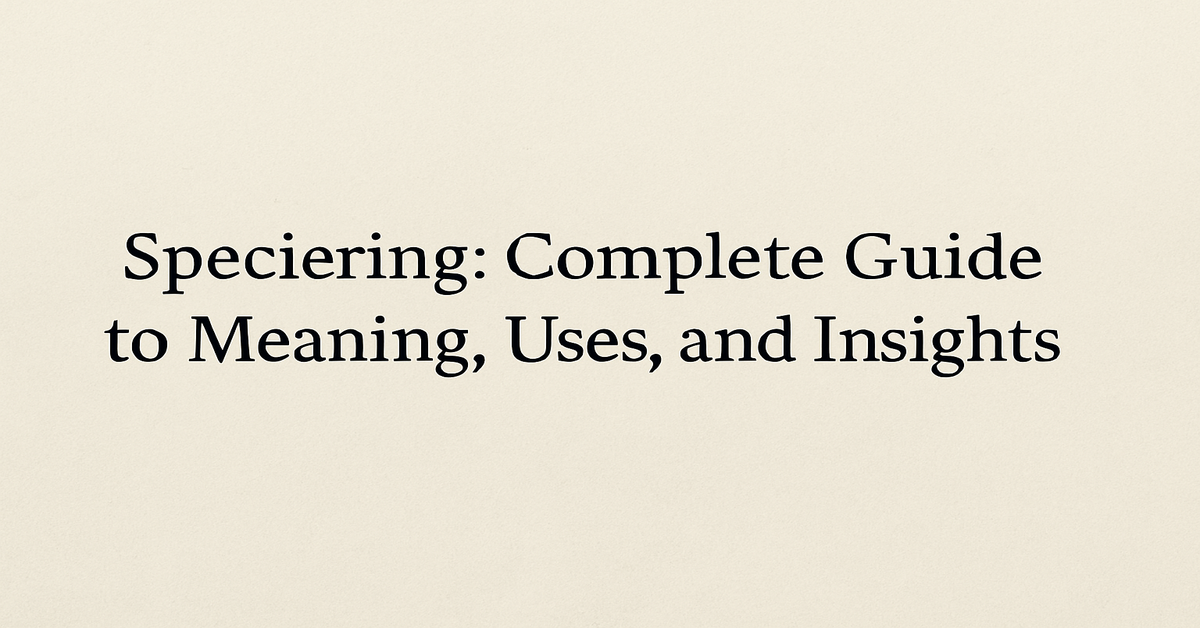
The word speciering is a specialized term that can be understood as a concept of classification, specification, and ordering in both technical and general contexts. At its essence, speciering reflects the practice of defining, categorizing, or breaking down elements into specific forms or categories for clarity and precision. This process is essential in disciplines ranging from engineering, manufacturing, and science to management, design, and even creative arts.
Unlike vague or generic terms, speciering highlights the importance of detail, structure, and organization. Whether it is specifying components in an engineering project, defining requirements in software development, or categorizing tasks in project management, speciering ensures that ambiguity is removed and that processes run smoothly.
In this comprehensive article, we will explore the meaning, importance, applications, processes, benefits, and challenges of speciering. By the end, you will have a deep understanding of how speciering functions as a practical framework across industries and why it continues to be relevant in our increasingly complex world.
Understanding Speciering
The term speciering is closely connected with the idea of specification—the act of providing detailed information about how something should be designed, structured, or executed. In technical language, to “specier” something means to break it into specific, measurable, and clearly defined elements.
For example:
- In construction, speciering means specifying the type of material, thickness, load-bearing capacity, and finish of a building element.
- In software, speciering refers to defining user requirements, functions, and technical standards.
- In manufacturing, speciering involves categorizing parts, dimensions, and tolerances for accurate production.
Thus, speciering is essentially about precision and clarity.
Importance of Speciering
Speciering is important because lack of specificity leads to confusion, errors, and inefficiency. In complex environments where multiple teams, tools, and goals intersect, precise instructions and specifications are crucial.
Some key reasons why speciering matters:
- Clarity of Communication: Everyone understands exactly what is required.
- Standardization: Processes and results become uniform and repeatable.
- Risk Reduction: Reduces errors and prevents costly mistakes.
- Efficiency: Saves time by minimizing misinterpretation.
- Quality Assurance: Ensures that final outcomes meet expectations.
Applications of Speciering Across Industries
Speciering is not restricted to one sector; it finds applications in diverse fields. Below are some examples of how it plays a role in different industries:
1. Engineering and Construction
Speciering ensures that design and execution match client requirements. Detailed specifications about materials, strength, dimensions, and safety standards guide engineers and contractors.
2. Manufacturing
In factories, speciering helps define part numbers, tolerances, and processes for consistency in production. Without it, mass production would lead to high defect rates.
3. Information Technology
Software engineers use speciering when drafting technical specifications, database structures, or coding standards. It defines exactly what a system should do.
4. Business and Management
Speciering in business refers to breaking down tasks into clear objectives, deadlines, and measurable performance standards.
5. Education and Research
In academic research, speciering refers to categorizing theories, methods, and data points for structured study.
Table: Speciering in Different Fields
| Field | Example of Speciering | Benefit |
|---|---|---|
| Engineering | Material grade, thickness, load | Safety and reliability |
| Manufacturing | Component size, tolerance | Quality control |
| IT | Software requirements doc | Reduced coding errors |
| Business | Project task breakdown | Improved management |
| Research | Data categorization | Structured analysis |
Process of Speciering
The act of speciering can be broken into stages:
- Identification: Determine what needs to be specified (e.g., a product, task, or process).
- Analysis: Break it down into measurable components.
- Documentation: Write clear specifications in a formal document.
- Verification: Check if the specifications are realistic and achievable.
- Implementation: Apply the specifications in real-world use.
- Review: Monitor performance against the specifications and refine if needed.
Benefits of Speciering
The advantages of practicing detailed speciering are immense:
- Accuracy: Removes ambiguity.
- Accountability: Each stakeholder knows their responsibilities.
- Consistency: Results are standardized.
- Traceability: Specifications can be tracked through documentation.
- Performance: Ensures efficiency and reliability.
Table: Benefits of Speciering
| Benefit | Explanation |
|---|---|
| Accuracy | Removes vague instructions |
| Accountability | Stakeholders have defined roles |
| Consistency | Standardized outcomes |
| Traceability | Documentation helps audits |
| Performance | Higher efficiency and quality |
Challenges of Speciering
Despite its importance, speciering also faces challenges:
- Over-Complexity: Too much detail may overwhelm users.
- Rigidness: Strict specifications may reduce flexibility.
- Miscommunication: Poorly written specs can still cause confusion.
- Cost and Time: Preparing detailed specifications requires resources.
Thus, while valuable, speciering must strike a balance between clarity and practicality.
Speciering in Modern Context
In today’s world, speciering has become even more relevant due to globalization, digitalization, and complex supply chains. With multiple stakeholders often spread across countries, specifications ensure that work is consistent regardless of location.
For instance:
- In global automotive manufacturing, parts from different countries must fit perfectly—achieved only through strict specifications.
- In IT outsourcing, clear software requirement specifications ensure that developers across continents deliver consistent results.
The Future of Speciering
Looking ahead, speciering will evolve with technology:
- AI-Assisted Specifications: Artificial intelligence will automate requirement drafting.
- Digital Twins: Specifications linked to digital simulations for real-time accuracy.
- Blockchain for Specs: Secure documentation of specifications to prevent tampering.
- Collaborative Platforms: Cloud tools enabling global teams to share and refine specs in real time.
- Sustainability Integration: Specifications will increasingly include eco-friendly and energy-efficient standards.
Conclusion
The concept of speciering may appear technical, but it plays a vital role across industries. At its heart, it is about clarity, accuracy, and order. By breaking down tasks, processes, or components into clear specifications, industries achieve safety, efficiency, and quality.
From engineering and construction to IT and research, speciering underpins modern progress. As technology advances, the process will become smarter, faster, and more globally integrated, making it an indispensable part of the future.
FAQs
1. What does speciering mean?
Speciering refers to the process of defining, categorizing, and specifying components, tasks, or requirements in precise detail.
2. Why is speciering important in industry?
It ensures clarity, reduces errors, improves efficiency, and guarantees that processes and results meet expected standards.
3. Which sectors use speciering most often?
Engineering, manufacturing, IT, business management, and research are key sectors that rely heavily on speciering.
4. What are the challenges of speciering?
Challenges include over-complexity, rigidness, resource demands, and the possibility of miscommunication if specs are unclear.
5. How will speciering evolve in the future?
With AI, blockchain, and digital twins, speciering will become more automated, secure, and integrated with sustainability goals.






